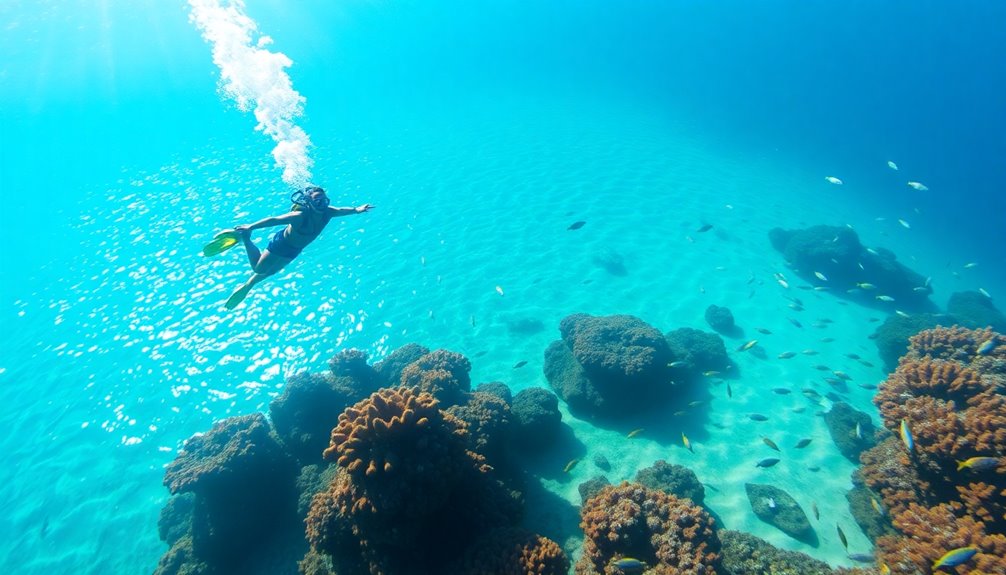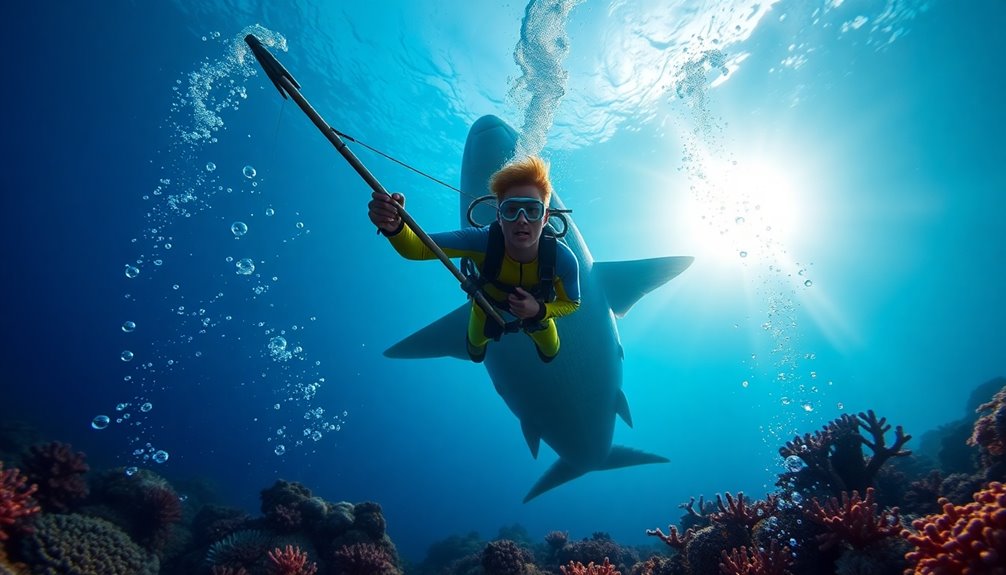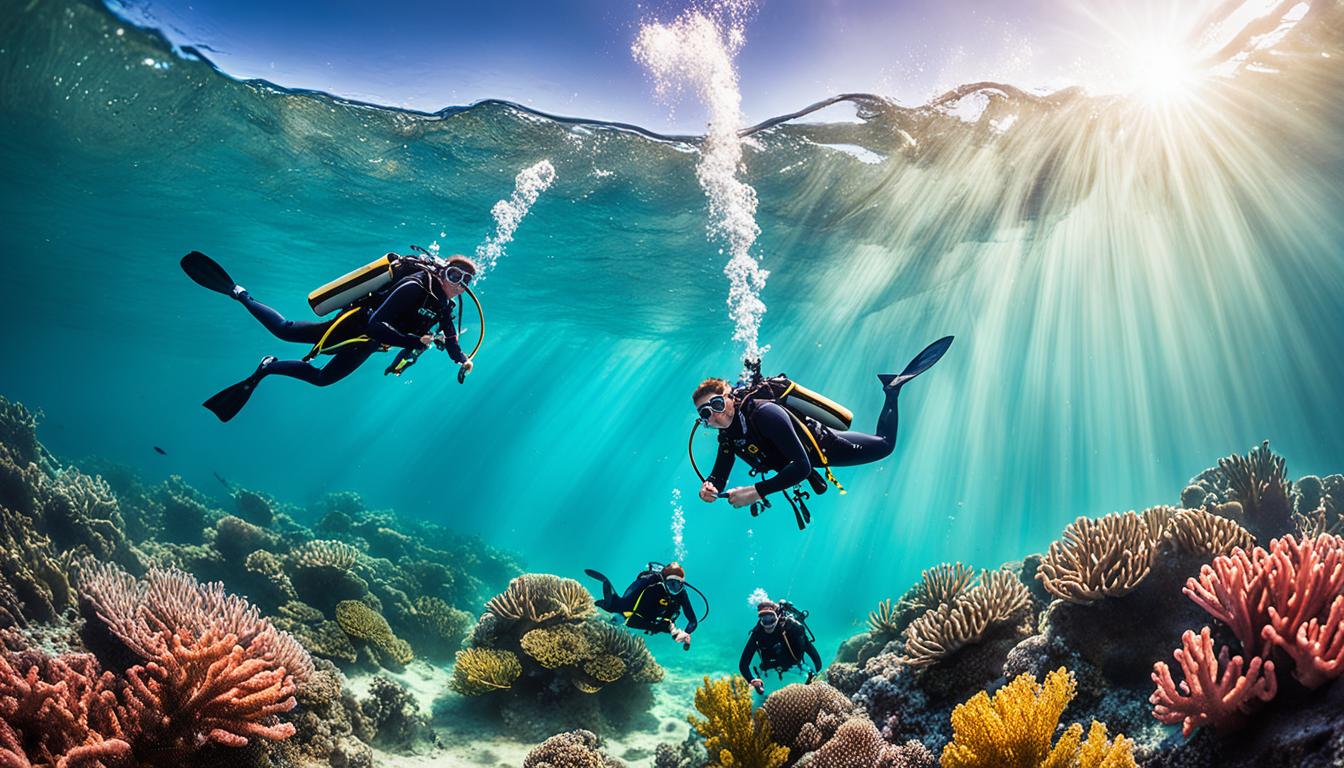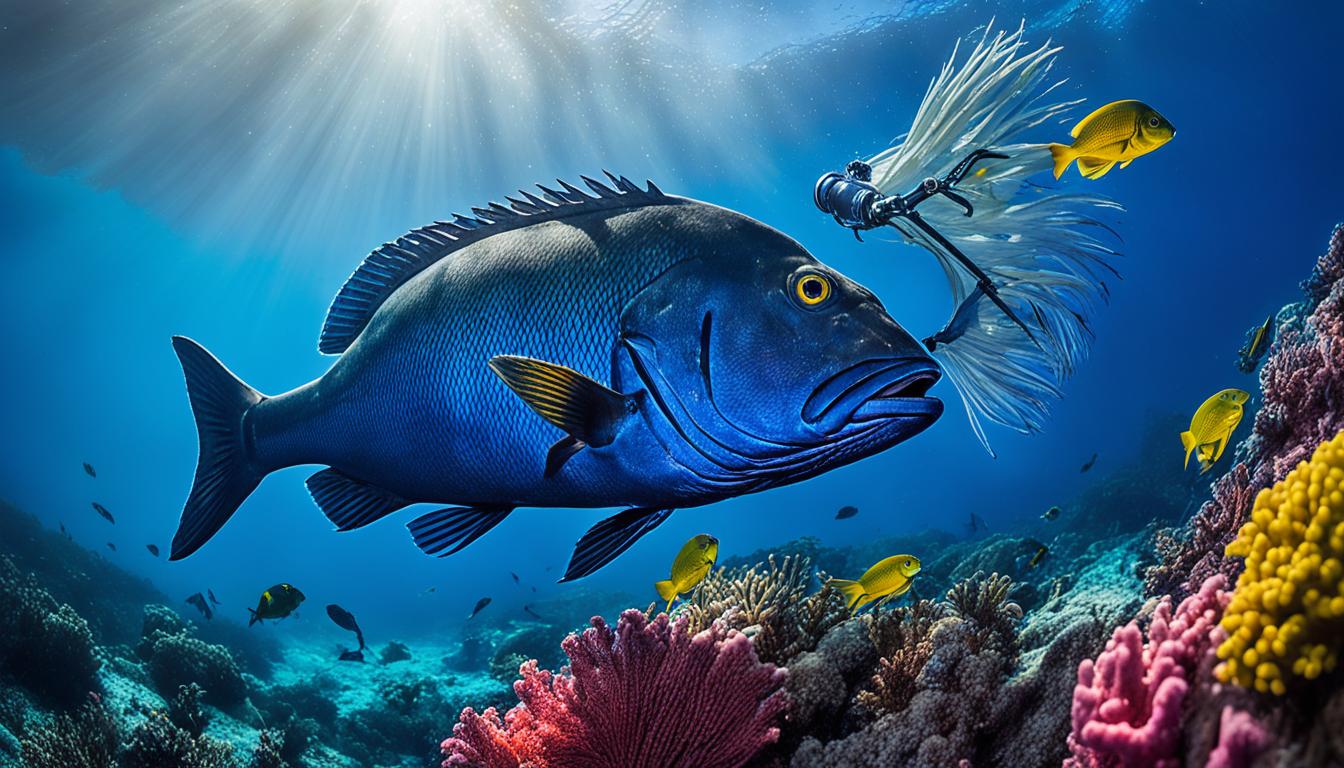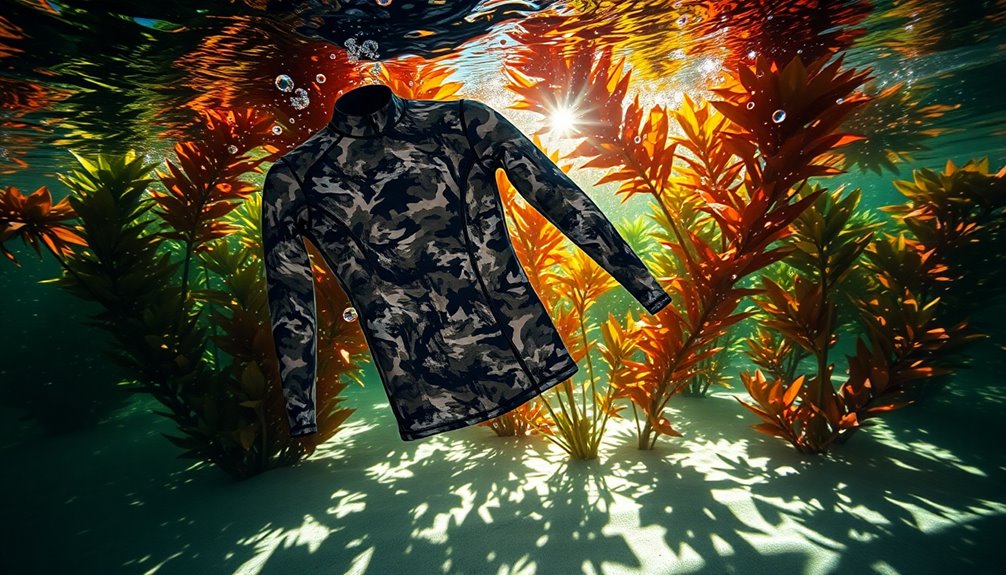Freediving near you is an exciting adventure waiting to be explored! You can dive into beautiful underwater worlds with just one breath, experiencing the thrill of swimming with marine life. There are different styles to try, like using fins or just your body. Make sure to wear the right gear, like a wetsuit and fins, to stay safe and comfortable. Remember to practice your breathing techniques and always dive with a buddy. It's a fun way to get fit and relax at the same time. Want to know where to find the best spots or other tips? Keep exploring!
Key Takeaways
- Explore local freediving locations like Honaunau Bay or Dahab for stunning underwater experiences and vibrant marine life.
- Join a certified freediving course to learn essential skills, safety guidelines, and breathing techniques.
- Ensure you meet age and skill requirements, including a swim test, before enrolling in a freediving class.
- Connect with local diving communities to share experiences and find diving buddies for safety and support.
- Invest in essential freediving gear like wetsuits and fins to enhance your underwater adventure and comfort.
What Is Freediving?

Freediving is an exhilarating form of underwater exploration that lets you dive on a single breath without the need for bulky scuba gear. In freediving, you hold your breath while exploring the amazing underwater world.
It's different from scuba diving because you don't use any breathing equipment. Instead, you rely on your own ability to dive deep and resurface safely. Freediving has been practiced since ancient times, primarily for food gathering, showcasing its long-standing significance in human culture.
Freediving can be both fun and challenging. It allows you to have a unique experience with fish, corals, and other sea creatures. You'll need to practice control and discipline to dive safely.
When you dive, your body reacts in incredible ways. Your heart rate slows down, and blood flow is directed to your vital organs, keeping you safe while you explore.
Regular freediving can improve your lung capacity and boost your overall health. It helps build strength and flexibility, just like swimming. Plus, it can even help you feel more relaxed and focused.
Types of Freediving
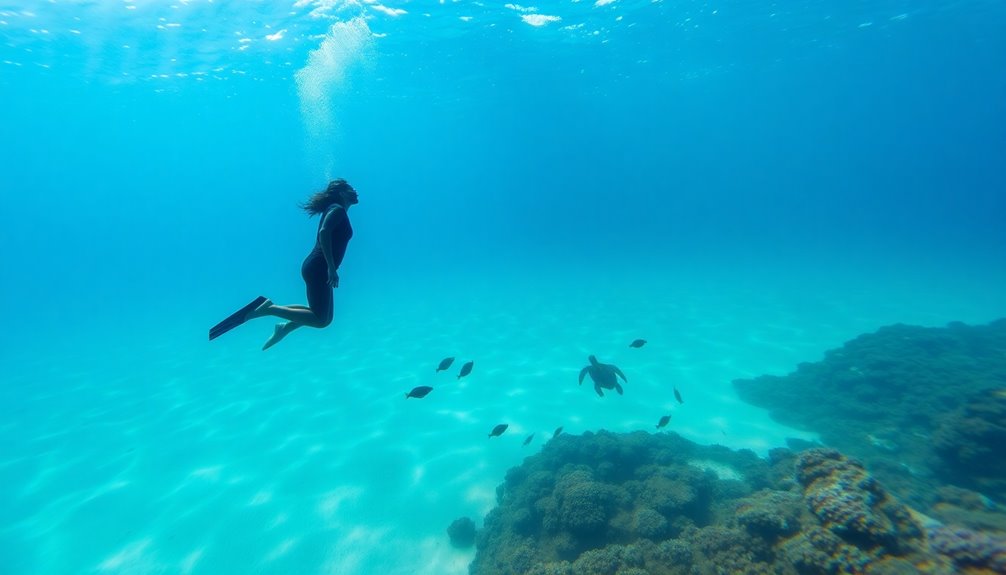
Exploring the types of freediving can open up a whole new world of underwater adventure. There are many exciting disciplines to try!
For instance, in Constant Weight (CWT), you use fins and your muscles to dive deep without pulling on ropes. It's a thrilling way to explore the depths! Efficient finning is essential in this discipline to reduce energy expenditure and enhance performance.
If you want a challenge, try Constant Weight Without Fins (CNF). Here, you use only your body to propel yourself, making it one of the toughest styles.
Free Immersion (FIM) lets you pull on a rope to help you dive down and come back up, focusing on technique.
When it comes to distance, Dynamic With Fins (DYN) is all about swimming horizontally in a pool using fins.
If you want to go fin-free, Dynamic Without Fins (DNF) is perfect for you! You'll need strong swimming skills to glide through the water.
For those who love breath-holding, Static Apnea (STA) is where you float and hold your breath. It's all about how long you can go!
Each type of freediving offers unique challenges and adventures waiting for you to discover!
Essential Freediving Equipment
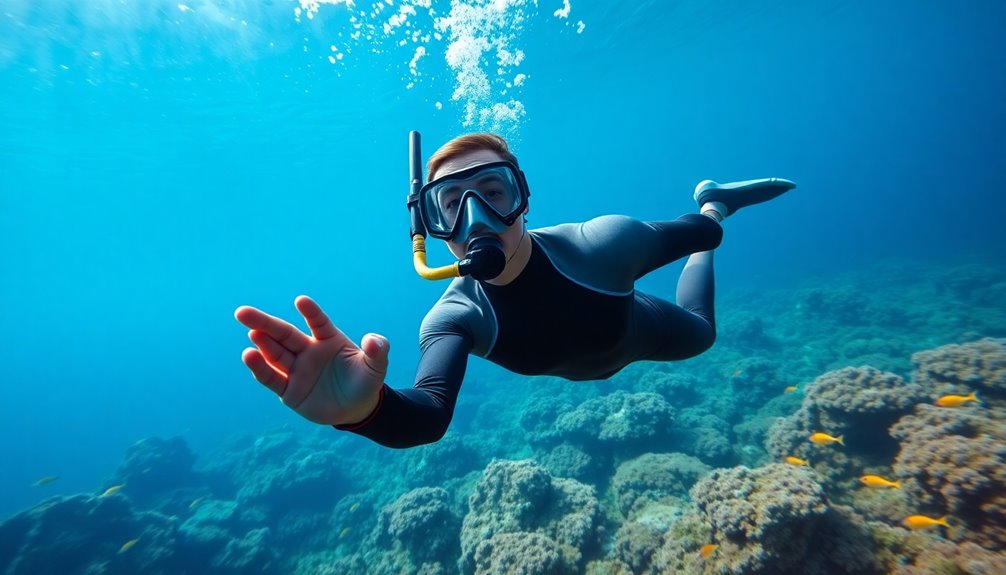
When you're gearing up for freediving, having the right equipment is essential for both safety and performance.
First up is your wetsuit. A good wetsuit keeps you warm and comfortable in the water. Look for one made from flexible neoprene. Off-the-rack suits usually cost between $250 and $400, while custom suits can be pricier. High-quality wetsuits are crucial for maintaining warmth and buoyancy during your dives.
Don't forget your weight belt! It helps you dive deeper and should be worn over your hips, not your waist, to make breathing easier.
Next, you'll need a mask and snorkel. A low-volume mask is best for easy pressure equalization and a clear view. Choose a simple "J-tube" snorkel for surface breathing, and make sure it's flexible to fit your head well.
Fins are also important. Long bladed fins are traditional, but if you're just starting, consider silicone or rubber fins for better technique. They can range from $119 to $159.
Lastly, safety gear like a dive computer, buoy, and a four-foot safety signal with a whistle can keep you safe while you explore.
Enjoy your adventures!
Breathing Techniques for Freediving
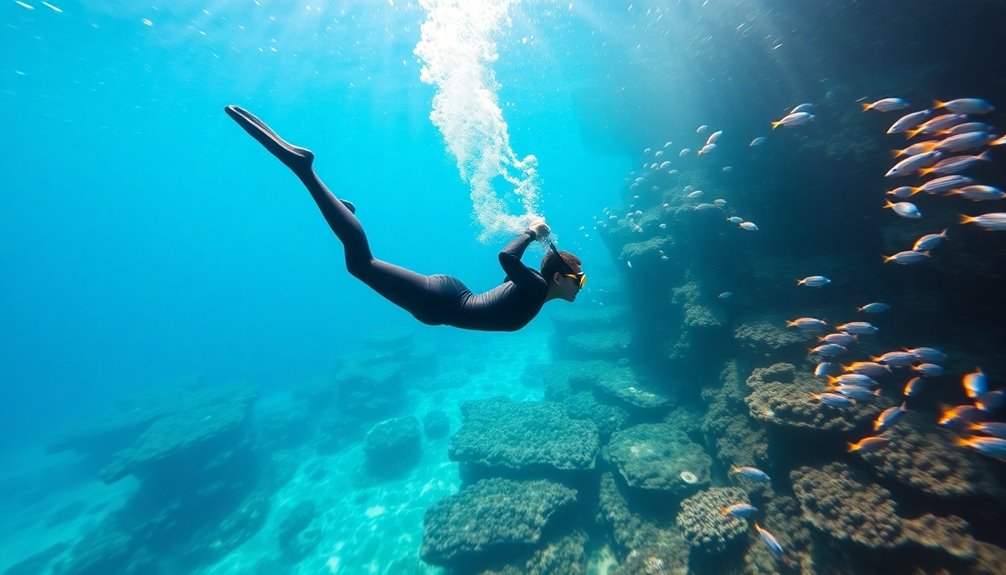
Mastering breathing techniques is crucial for your success and safety in freediving. When you prepare for a dive, start with relaxed breathing. Inhale and exhale gently to keep your heart rate low and avoid straining your muscles.
Try segmented inhalation, filling your stomach first, then your rib cage, and finally your upper lungs. This helps you take in more air! Remember that oxygen is stored in myoglobin, hemoglobin, and lungs to enhance your dive performance. Additionally, proper breathing techniques can significantly improve your overall performance underwater.
Don't forget about exhaling! A longer exhalation than inhalation calms your body and reduces oxygen consumption. Pauses between breaths are also important; take a moment after inhaling and exhaling to feel more relaxed.
Remember, only take two complete breaths before diving to avoid hyperventilation.
To increase your lung capacity, practice segmented breathing exercises. Isolate different muscle groups, filling your lungs in stages. Pursed lip breathing can strengthen your air control too!
After your dive, follow recovery breathing. Don't exhale until you're clear of the water, then take a quick, deep breath followed by a short, relaxed exhalation.
Repeat this cycle for at least 30 seconds to help your body re-oxygenate. With practice, you'll feel more confident and ready to explore the underwater world!
Safety Guidelines for Divers
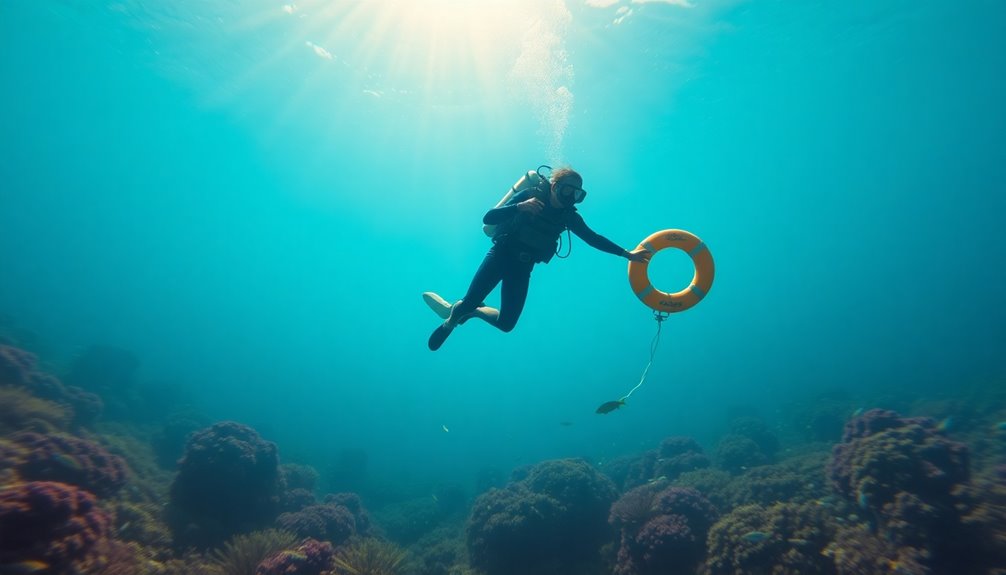
Safety is a top priority for anyone engaging in freediving. Always dive with a buddy who matches your skill level. This way, you can support each other and stay safe. Never dive alone! Your buddy should be able to rescue you if needed. After you surface, keep an eye on each other for at least 30 seconds to make sure everyone is okay.
Using the right gear is also important. Wear a freediving wetsuit to stay warm and protected from the sun. Freediving fins help you move quickly and easily in the water. Remember to use a weight belt so you're positively buoyant at the surface, even after exhaling. A dive computer and buoy can help keep your dives safe and controlled.
Before diving, plan your dive together. Check sea conditions and make sure you're both ready. Don't forget to remove your snorkel before diving and avoid exhaling underwater. Additionally, it's crucial to maintain visual contact with your buddy throughout the dive to ensure safety.
If you feel tired or cold, it's best to skip the dive. Always know how to handle emergencies and practice safety procedures. By following these guidelines, you'll make sure you have an exciting and safe freediving adventure!
Courses for Beginners and Experts
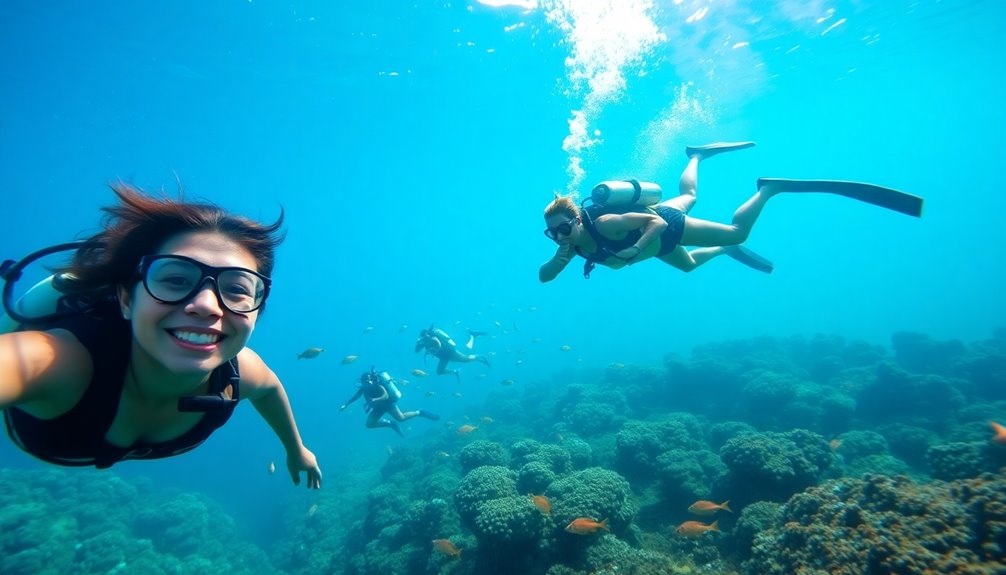
Embarking on a freediving journey opens up a world of adventure, whether you're just starting out or looking to refine your skills. For beginners, agencies like AIDA, SSI, and Molchanovs offer exciting courses. These courses often start with online training, and then you get to practice in the water!
You'll learn important things like breathing techniques and safety skills. Most beginner courses let you dive to depths between 5 and 20 meters, and you can swim up to 100 feet in confined water. Additionally, the academy offers group packages that include discounts and accommodation options for those looking to join with friends or family.
If you're ready to take it to the next level, advanced courses are available too! These build on what you've already learned and can take you deeper—up to 30 meters. You'll master advanced techniques, like freefalling and constant weight diving. Plus, you can specialize in fun disciplines like dynamic apnea.
Courses usually have age requirements, like being at least 10 or 12 years old, and you'll need to swim 100 meters without aids. Prices range from $155 to $480, covering everything from gear rental to certification fees.
Finding Freediving Locations Nearby
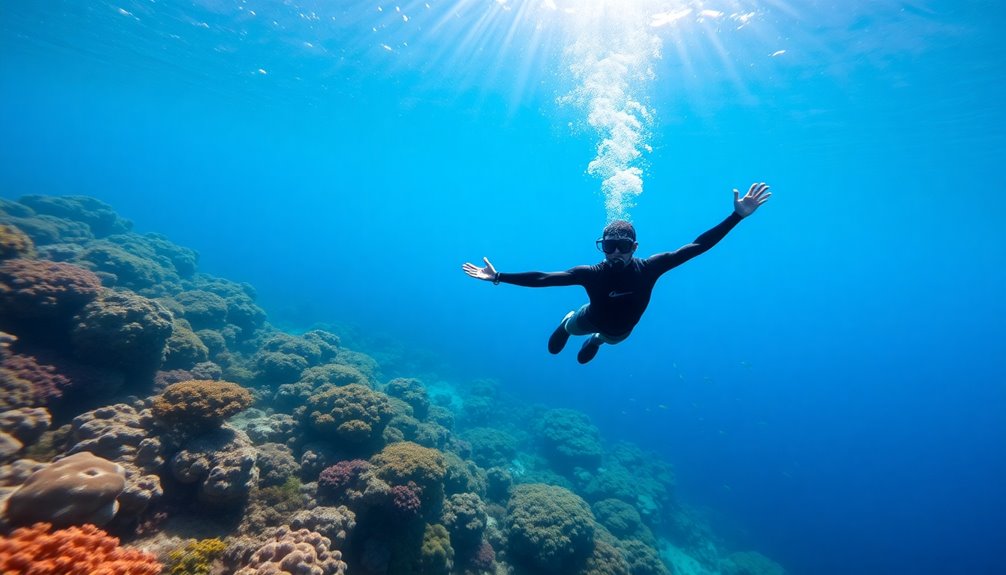
Once you’ve completed your freediving courses, the next step is to explore the best locations to practice your skills. You’re in for an exciting adventure! Whether you’re drawn to vibrant coral reefs, serene underwater caves, or crystal-clear lakes, the world is filled with breathtaking spots to dive into your new passion. Don’t forget to check for freediving courses available nearby, as these can help you refine your technique and enhance your safety while exploring. Each new location presents unique challenges and experiences, making your journey as a freediver all the more fulfilling.
Start by checking out local spots like Honaunau Bay in Hawaii. It has clear waters and friendly sea turtles that love to greet divers.
If you're looking for something unique, the Blue Hole in Dahab, Egypt, offers calm waters and vibrant coral, perfect for beginners. Additionally, the Blue Hole is a must-visit for its iconic marine animals, including a variety of fish and possibly even a hammerhead shark sighting.
If you want to travel a bit further, consider visiting the Gili Islands in Indonesia. With warm water and clear visibility, it's a fantastic spot for both beginners and experts.
The Philippines is another amazing choice, featuring sites like Coron Bay with WWII wrecks and stunning marine life.
For a real challenge, try the Great Blue Hole in Belize. It's deep and filled with diverse creatures.
Each of these locations has something special to offer. So grab your gear, invite some friends, and dive into the incredible underwater world waiting for you. You're sure to find a spot that makes your heart race with joy!
The Benefits of Freediving

Freediving offers a unique blend of physical, mental, and emotional benefits that can transform your overall well-being. When you dive underwater, your lungs get stronger, boosting your respiratory function. You'll find that your heart becomes healthier too, which helps reduce the risk of heart problems. Additionally, consistent training in freediving significantly improves lung function, allowing you to take deeper breaths while swimming.
Plus, as you swim against the water, you're building muscular strength and endurance in your core, arms, and legs.
Freediving also works wonders for your mind. It helps reduce stress and anxiety through calming breathing techniques. You'll gain confidence in yourself and improve your focus and concentration, almost like meditation!
The peacefulness of being underwater encourages mindfulness, allowing you to relax and enjoy the moment.
Moreover, freediving increases your flexibility and overall fitness, making you feel more agile and fit. It also teaches vital water safety skills, keeping you safe during your adventures.
You'll learn to be aware of your body and improve your breathing techniques, which can make a big difference.
In short, freediving opens up a world of benefits that make you stronger, calmer, and more aware, both in and out of the water!
Frequently Asked Questions
What Are the Health Benefits of Freediving?
Freediving has amazing health benefits for you! It boosts your lung capacity, helps your heart, and even lowers your blood pressure.
You'll feel less stressed and anxious, too, as each dive can clear your mind and build your confidence.
Plus, it strengthens your muscles and improves your endurance!
You'll connect with nature in a unique way while enjoying a fun and healthy activity that promotes overall wellness.
Dive in and feel great!
Can I Practice Freediving in Freshwater Locations?
Yes, you can definitely practice freediving in freshwater locations!
Places like Lake Macquarie and the cenotes in Mexico offer clear waters and exciting underwater sights. These spots are perfect for all skill levels.
Just remember to follow safety rules, dive with a buddy, and take your time to enjoy the experience.
Exploring freshwater environments can be a fun adventure, letting you discover unique marine life while enjoying the beauty of nature!
How Do I Choose a Freediving School?
Choosing a freediving school can be exciting! Start by checking if they're linked to trusted organizations like SSI or FII.
Look for experienced instructors and see what courses they offer. Make sure you understand the training structure, including safety practices.
Check the age and health requirements, too. Lastly, see if they provide practical training in pools and open water.
With the right school, you'll dive into a fantastic adventure!
What Should I Eat Before a Freedive?
Before your freedive, it's best to eat about 2-3 hours earlier.
You can grab a light snack, like a banana or some oats, for quick energy. If you're diving for a longer time, consider a healthy meal with protein and veggies.
Avoid heavy foods that might make you feel bloated. Remember to stay hydrated, too!
This way, you'll feel great and ready to explore underwater wonders. Happy diving!
Are There Age Restrictions for Freediving?
Yes, there are age restrictions for freediving! You can start an introduction day at just 10 years old.
If you're 12 or older, you can take beginner courses with parental consent. For advanced courses, you need to be at least 15.
Once you reach 18, you can dive even deeper and become an instructor!
Always remember, you'll need good swimming skills and the right equipment to stay safe while having fun underwater!
Conclusion
Freediving is an amazing adventure waiting for you! Whether you're just starting out or already an expert, there's so much to explore beneath the waves. With the right equipment, breathing techniques, and safety tips, you can dive into a whole new world. So, grab your gear, find a local spot, and enjoy the beauty of the ocean. It's not just about diving; it's about the joy of discovering what lies beneath the surface! Happy diving!

